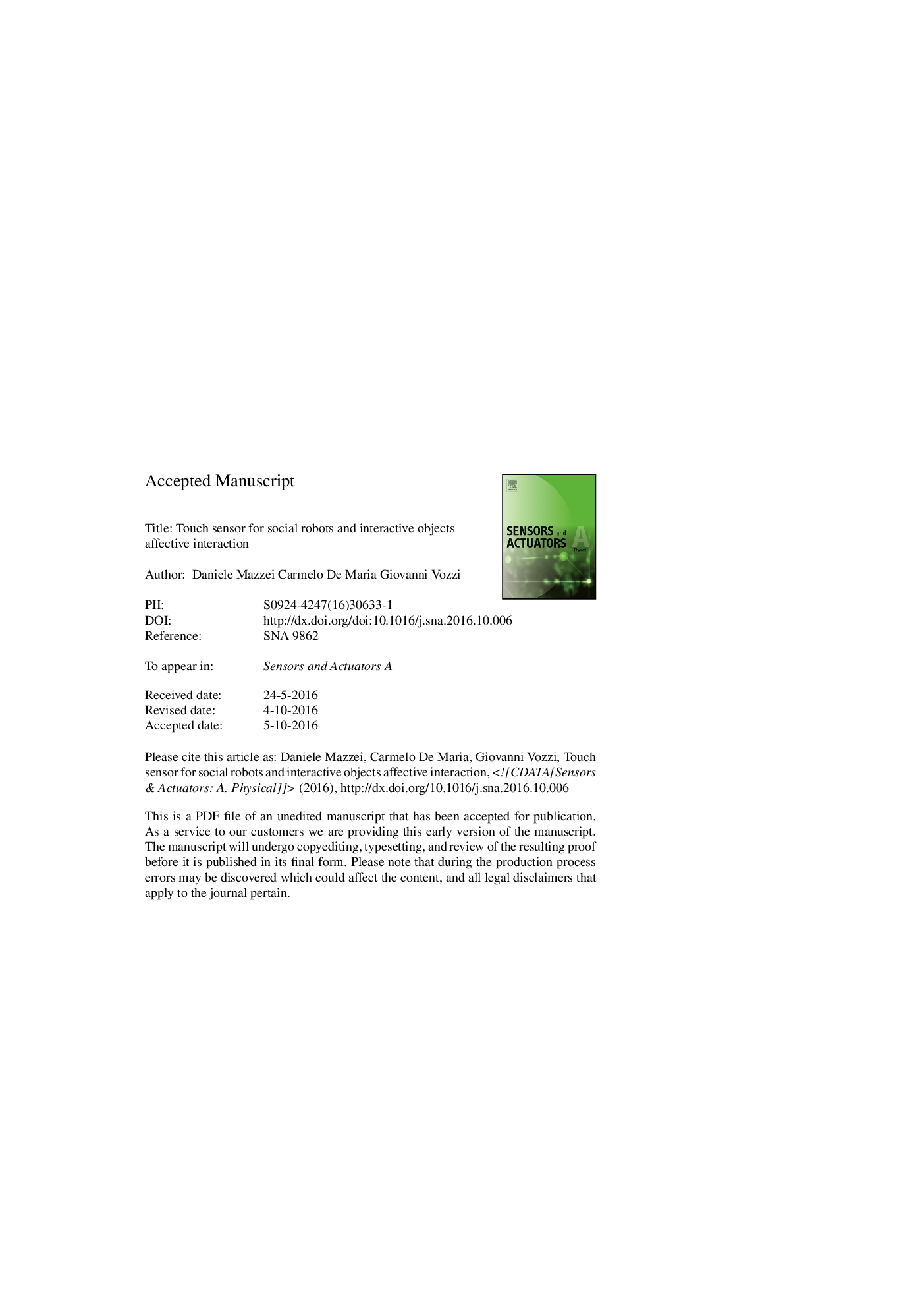| کد مقاله | کد نشریه | سال انتشار | مقاله انگلیسی | نسخه تمام متن |
|---|---|---|---|---|
| 5008541 | 1461849 | 2016 | 27 صفحه PDF | دانلود رایگان |
عنوان انگلیسی مقاله ISI
Touch sensor for social robots and interactive objects affective interaction
ترجمه فارسی عنوان
سنسور لمسی برای روبات های اجتماعی و تعاملات عاطفی تعاملی
دانلود مقاله + سفارش ترجمه
دانلود مقاله ISI انگلیسی
رایگان برای ایرانیان
کلمات کلیدی
تعامل دقیق، رباتیک عاطفی سنسور لمسی سنسور سیلیکون انعطاف پذیر،
ترجمه چکیده
اهمیت شناخته شده تجربه فیزیکی در مبادلات همدلی، منجر به توسعه سنسورهای لمسی برای تعامل عاطفی انسان و ربات شده است. اکثر این سنسورها که به عنوان ماتریس سنسورهای فشار به کار رفته اند، سفت و سخت می باشند، نمی توانند در اشکال پیچیده ساخته شوند، نمی توانند تحت تاثیر تغییرات بزرگ قرار گیرند و معمولا تنها رویداد تماس را بدون هیچ گونه اطلاعاتی در مورد چارچوب تعامل، می گیرند. این مقاله یک حسگر لمسی شونده را ارائه می دهد که قادر به گرفتن کل زمینه تعامل از جمله حرکات و الگوهای است. سنسور از لایه های متفاوتی از سیلیکون حساس و عایق ساخته شده است: ماهیت نرم سنسور آن را قادر به سازگاری با اجزای پیچیده و قابل تغییر می کند. ویژگی های اصلی سیگنال های الکتریکی با تجزیه و تحلیل مولفه های اصلی استخراج می شود و یک شبکه عصبی سازماندهی خود مسئول طبقه بندی و شناسایی فضایی وقایع برای تایید و اندازه گیری ژست است. نتایج به برنامه های جالب باز می شود که از تولید اسباب بازی ها، به تعامل انسان و ربات و حتی تجهیزات و برنامه های کاربردی ورزشی و بیومدیکال رنج می برد.
موضوعات مرتبط
مهندسی و علوم پایه
شیمی
الکتروشیمی
چکیده انگلیسی
The recognised importance of physical experience in empathic exchanges has led to the development of touch sensors for human-robot affective interaction. Most of these sensors, implemented as matrix of pressure sensors, are rigid, cannot be fabricated in complex shapes, cannot be subjected to large deformations, and usually allow to capture only the contact event, without any information about the interaction context. This paper presents a tactile flux sensor able to capture the entire context of the interaction including gestures and patterns. The sensor is made of alternate layers of sensitive and insulating silicone: the soft nature of the sensor makes it adaptable to complex and deformable bodies. The main features from electrical signals are extracted with the principal component analysis, and a self-organising neural network is in charge for the classification and spatial identification of the events to acknowledge and measure the gesture. The results open to interesting applications, which span from toy manufacturing, to human-robot interaction, and even to sport and biomedical equipment and applications.
ناشر
Database: Elsevier - ScienceDirect (ساینس دایرکت)
Journal: Sensors and Actuators A: Physical - Volume 251, 1 November 2016, Pages 92-99
Journal: Sensors and Actuators A: Physical - Volume 251, 1 November 2016, Pages 92-99
نویسندگان
Daniele Mazzei, Carmelo De Maria, Giovanni Vozzi,
